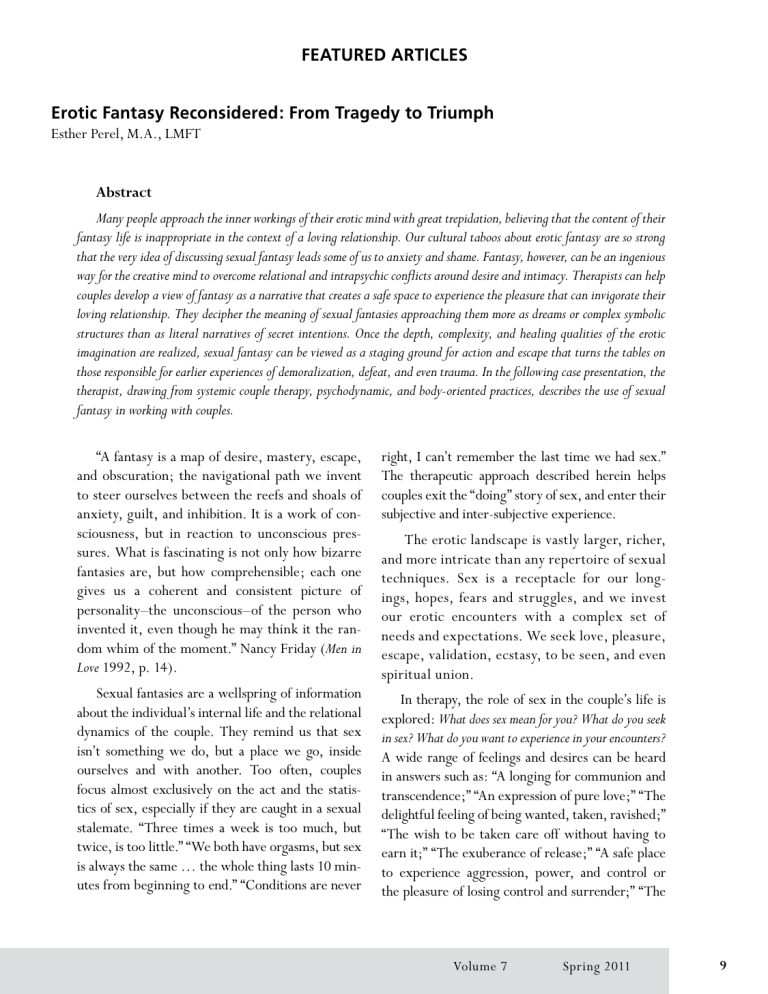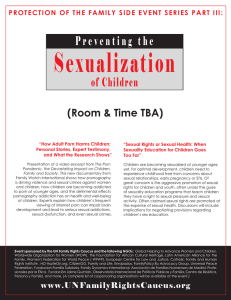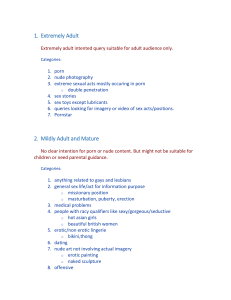
FEATURED ARTICLES
Erotic Fantasy Reconsidered: From Tragedy to Triumph
Esther Perel, M.A., LMFT
Abstract
Many people approach the inner workings of their erotic mind with great trepidation, believing that the content of their
fantasy life is inappropriate in the context of a loving relationship. Our cultural taboos about erotic fantasy are so strong
that the very idea of discussing sexual fantasy leads some of us to anxiety and shame. Fantasy, however, can be an ingenious
way for the creative mind to overcome relational and intrapsychic conflicts around desire and intimacy. Therapists can help
couples develop a view of fantasy as a narrative that creates a safe space to experience the pleasure that can invigorate their
loving relationship. They decipher the meaning of sexual fantasies approaching them more as dreams or complex symbolic
structures than as literal narratives of secret intentions. Once the depth, complexity, and healing qualities of the erotic
imagination are realized, sexual fantasy can be viewed as a staging ground for action and escape that turns the tables on
those responsible for earlier experiences of demoralization, defeat, and even trauma. In the following case presentation, the
therapist, drawing from systemic couple therapy, psychodynamic, and body-oriented practices, describes the use of sexual
fantasy in working with couples.
“A fantasy is a map of desire, mastery, escape,
and obscuration; the navigational path we invent
to steer ourselves between the reefs and shoals of
anxiety, guilt, and inhibition. It is a work of consciousness, but in reaction to unconscious pressures. What is fascinating is not only how bizarre
fantasies are, but how comprehensible; each one
gives us a coherent and consistent picture of
personality–the unconscious–of the person who
invented it, even though he may think it the random whim of the moment.” Nancy Friday (Men in
Love 1992, p. 14).
right, I can’t remember the last time we had sex.”
The therapeutic approach described herein helps
couples exit the “doing” story of sex, and enter their
subjective and inter-subjective experience.
Sexual fantasies are a wellspring of information
about the individual’s internal life and the relational
dynamics of the couple. They remind us that sex
isn’t something we do, but a place we go, inside
ourselves and with another. Too often, couples
focus almost exclusively on the act and the statistics of sex, especially if they are caught in a sexual
stalemate. “Three times a week is too much, but
twice, is too little.” “We both have orgasms, but sex
is always the same … the whole thing lasts 10 minutes from beginning to end.” “Conditions are never
In therapy, the role of sex in the couple’s life is
explored: What does sex mean for you? What do you seek
in sex? What do you want to experience in your encounters?
A wide range of feelings and desires can be heard
in answers such as: “A longing for communion and
transcendence;” “An expression of pure love;” “The
delightful feeling of being wanted, taken, ravished;”
“The wish to be taken care off without having to
earn it;” “The exuberance of release;” “A safe place
to experience aggression, power, and control or
the pleasure of losing control and surrender;” “The
The erotic landscape is vastly larger, richer,
and more intricate than any repertoire of sexual
techniques. Sex is a receptacle for our longings, hopes, fears and struggles, and we invest
our erotic encounters with a complex set of
needs and expectations. We seek love, pleasure,
escape, validation, ecstasy, to be seen, and even
spiritual union.
Volume 7
Spring 2011
9
melting of bodies which unleashes a unique kind
of vulnerability and intimacy;” “The permission
to relinquish responsibility and to step out of one’s
familiar roles;” “An act of rebellion against social
conventions and the excitement of toppling the
rules of good citizenship;” “The experience of freedom, playfulness, naughtiness and transgression”;
“The trespassing of taboos;” “A temporary merging being simultaneously in and out of one’s body,
inside oneself and inside an-other.” Or simply as one
partner said: “To feel good.”
Our emotional history shapes our erotic blueprint and is expressed in the physicality of sex.
Accordingly, there is a strong connection between
our attachment map–defined as our expectations, conflicts, hopes and disillusionment with
intimate connections–and our sexual feelings and
behaviors: Tell me how you were loved, and I’ll
tell you how you make love. Were our parents
or caregivers responsive to our needs or were we
expected to monitor theirs? Did we turn to them
for protection or did we flee to protect ourselves?
Was pleasure celebrated, suspiciously tolerated or
simply dismissed? Did we feel safe to trust? Were
we rejected? Humiliated? Abandoned? Were we
held? Rocked? Soothed? Did we learn to receive
or to be denied; to dare or to be afraid? Did we
figure out not to expect too much and to hide
when we were upset? In our family, we sense
when it’s okay to thrive and when others might
be hurt by our zest. We learn how to feel about
our body, our gender and our sexuality. And we
learn a multitude of other lessons about whom to
be and how to act that seep straight into our erotic
life. All these experiences shape our beliefs about
ourselves and our expectations from others. They
are part of the dowry each man and woman brings
to the unknown continent of adult love. Part of
this emotional scorecard is obvious, but much of it
is unspoken, concealed even from ourselves.
Upon careful listening to clients’ erotic revelations, it becomes clear that fantasies are an imaginary transposition of their emotional needs into the
10
American Family Therapy Academy
creation of a paradigmatic erotic schema. A valuable
creative resource, fantasies transform our emotional and existential quests into sources of pleasure. They offer us an imaginary pathway to repair,
compensate, and transform. A couple is a gathering
place where we bring these imaginary elaborations
to bear. There is a dialectical relation between the
power and dominance, the surrender, the dependency, and the care that we toy with in our sexual
fantasies and the reality of a couple’s life. The same
power imbalance we fight about in the kitchen, may
incite our sexual excitement after dinner. It is, however, beyond the scope of this article to delve into
the tensions and inconsistencies of power dynamics
in couples and the intersections with sex.
One patient Joanna, a 51 year-old lab technician, has always approached the inner workings of
her erotic mind with great trepidation. “Something
would creep in and it would be dismissed before it
could ever develop,” she says. “You know, my fairy
tale fantasy has always been ‘Oh, why don’t we just
cuddle? Wouldn’t it be nice to just, like, rub my
back?’ But I realized my fantasy was very different.”
Tell me how you were loved, and I’ll
tell you how you make love.
She describes herself as a child living in the background of her family, often feeling invisible. She
tells the story of how one night she woke up vomiting in her bed, afraid to call her parents for fear
that it would disturb them and that they wouldn’t
take her seriously. She left a crumb on the side of
her mouth, hoping that someone would notice her
distress in the morning. They didn’t.
The theme of invisibility looms large in the
making of her erotic blueprint. It is dominated
by the words: “I have enough, I don’t need any
more.” The intricacies of our desire often lie buried in the details of our childhood. Our sexual
proclivities, arise from the thrills, challenges and
Monograph Series
Perel
conflicts of our early life.
receive, legitimately and abundantly.
Joanna tells me that she has a deep wish for
people to see her. “I want them to notice me, to
watch me, to admire me, to know me.” “Is this wish
realized in your fantasies?” I ask. She tells me that
she likes to be blindfolded and tied up. “In my fantasies, it’s all about me. I don’t have to do anything.”
I try to decipher the meaning of sexual fantasies by
approaching them more as dreams or complex symbolic structures than as literal narratives of secret
intentions. What happens in the fantasy of “tie me
up” that meets that need?
Understanding what fantasies do for our clients helps therapists to understand the emotional
needs they bring to their sexual encounters. A
good fantasy states the problem and offers the solution. It is an ingenious way for our creative mind
to overcome all sorts of relational and intrapsychic
conflicts around desire and intimacy. Psychoanalyst
Michael Bader (2002), whose brilliant book Arousal
offers an in-depth discussion of the undercurrents
of fantasy, explains that in the sanctuary of the
erotic mind we find a psychological safe space to
undo the fears, inhibitions and prohibitions that roil
within us. Joanna frees herself from her psychological constraints and the limits put upon her by her
conscience and her self-image. The ability to go
anywhere in our imagination is a pure expression
of individual freedom. It is a creative force that can
help us momentarily transcend reality. In the playful twist of her erotic imagination, being entrapped
unleashes her freedom.
Joanna explains: “When I am tied up, I don’t
have to think, I don’t have to give or be nice. I cannot not let you give to me and I can’t give anything
because I’m tied up.”
Understanding what fantasies
do for our clients helps therapists
to understand the emotional
needs they bring to their sexual
encounters. A good fantasy states
the problem and offers the solution.
Recognizing the depth, complexity and healing qualities of the erotic imagination, we explore
sexual fantasy as a staging ground for action and
escape that turns the tables on those responsible for
earlier experiences of demoralization, defeat and
even trauma.
For Joanna, the restraint is not about force or
being over powered. Rather it bypasses the ways
that she stops herself from receiving pleasure, a
lifelong habit of self-abnegation and disappearing in
the background. When she is tied up she can only
be given to, she needs not worry and feel guilty that
she’s taking too much, and she feels no pressure to
instantly return the favor. In her fantasy, she is put
in a situation where she has no other choice but to
Sex therapist Jack Morin (1995) explains that
the erotic imagination is inventive in undoing,
transforming, and redressing the traumas of the
past. The very experiences that caused us the most
pain in childhood sometimes become the greatest
sources of pleasure and excitement later on.
Joanna’s husband, Carl, recounts one of his
formative memories: One evening as he sat next to
his mother on the sofa watching TV, he unexpectedly brushed his leg against her skin and instantly
recoiled in fear, a powerful blend of terror and longing. The tenderness he craved was a transgression
into dangerous territory. This incident became a
seminal experience in the shaping of his erotic
blueprint. Carl’s mother spent much time on the
sofa smoking cigarettes and watching soap operas
on television and he learned to hide his vulnerabilities and need for tender connection.
During the day, Carl was an engineer in
charge of an entire division. After hours, his
libidinal pursuits went in overdrive with on-line
Volume 7
Spring 2011
11
porn, or off-line revelries, all depicting older
women and young men/boys. In his imaginary
world, the adult Carl could experience the needs
the little boy had to repress – tenderness, softness, vulnerability, and dependency. All these
repudiated emotions fueled his erotic scripts.
There, Carl the man can play the little boy without suffering the pain of the little boy who was
refused the soothing, loving touch of mother. In
his fantasies he is not needy: the women always
want him, they never say no, they know exactly
what he needs and are happy to give it to him.
Reliving the little boy is frightening; to play him
is enchanting. Fantasies express truths about
ourselves that are hard to get at otherwise. They
reveal us at our most bare, and in their own mysterious way they convey our deepest wishes.
Unfortunately, Carl’s metaphors got confused. Need and desire got mixed up. Joanna
is clear about that. “I don’t mind nurturing the
little boy, but I don’t want to have sex with the
little boy.” She sees him as demanding; he sees
her as withholding. She wishes he would desire
her, he says why don’t you want me? And both
are saying: “See me, hear me, touch me, feel me.”
Delving into narratives of fantasies, de-pathologizing them, translating the metaphors and the
power of the turn-ons, connecting them to the
person’s emotional history, and then creating a
bridge between past and present, self and other,
are important steps in the therapeutic process.
While for some, sharing fantasies is intimate (the
exposure of a unique nudity to one’s partner) others would rather maintain an intimacy with themselves and prefer to host their revelries privately.
This paper does not do justice to the intricacies
and dilemmas of fantasy disclosure: Whether to
tell ? When? How? What for? Whether to enact
them, and if so, how far? This paper discusses
how we can use fantasies in therapy as a metaphoric language to address sexual impasses in
the individuals and in the couple. Narrating our
fantasies is an exercise in self-description, which
12
American Family Therapy Academy
in turn promotes differentiation between partners. It elicits separateness and curiosity, which
is at once alluring and threatening. To turn the
spotlight on oneself, and to invite the other into
a vulnerable territory puts responsibility on each
person to own whom they are. It is the other side
of blame. It involves not only trusting the other,
but also the belief that one is worth being known,
loved and desired.
When clients open the door to their imaginary
musings, offering literal translations can be tempting. Yet, any element of a fantasy–any object, toy,
type of light, time of day, smell or smile–has a
subjective meaning that only the author of the plot
stands to interpret.
One day, Joanna planned a sexual encounter.
She put a note on the door that read “Help me!”
and then she tied herself to the bed. When Carl
arrived she sensed his hesitation, but she stayed
focused on herself, and did not worry about him.
Her desire wasn’t contingent on him; it was
about her.
As a child, Joanna would leave minor marks
on her body, like the crumb mentioned previously, hoping to be noticed. She was accustomed
to receiving little response from her parents, and
had learned to protect herself from disappointment by leaving signs that were so subtle that,
if nobody noticed them, she could easily pretend
they never existed. We named this the “crumb
approach.” For many years she would initiate sex
with Carl using the same subterfuge. She would
come on to him in a vague and non-committal
manner so that when he refused her advances, it
was barely evident she had ever taken initiative.
That day, she didn’t just leave a crumb on her
lip, she put herself in full view. There was nothing sheepish or tentative about her seduction.
Not surprisingly, Joanna reveals that this was
the first time in decades that she had an orgasm
with Carl. She describes how she felt alive. We
agree that the energy comes from her sense of
Monograph Series
Perel
self-worth, and healthy entitlement that drive
her action. Joanna was in the realm of desire, of
owning the wanting. The script is sexual, but the
risks she takes and the healing she experiences
are quintessentially emotional. The pleasure is
commensurate with the meaning, far beyond its
specific theatricality.
Reflecting on her boldness, Joanna tells me
that in the past she would immediately whisk away
any sexual thought she had. As she has become
more comfortable with her thoughts, more open
and connected to her sexuality, she meets herself
anew. “I realized that I wanted to be dominated.
I wanted him to be rough, which was so far away
from where I ever thought or even dreamed that
I would be. I didn’t want to be hurt, though. I
was very aggressive, very forthcoming with my
wants. ‘I would like you to tie me up. I would like
you to blindfold me. I don’t want to know what
you’re going to do until you do it.’ Like that. And
it was good. She said, “Oh my God, this is what it
feels like to be alive.”
When I inquired if she had feared Carl’s reaction, she smiled and showed me with her hand
how she had blindfolded herself. Some people
may be very scared to place themselves in such
an explicitly helpless state, but for Joanna, being
unable to see freed her from self-consciousness,
inhibition, and worry about Carl’s reaction. Her
disempowerment was a staged, assertive, and
playful way to get Carl’s attention, and he could,
in turn, sidestep the allusions to the depressed
mother on the couch. This time, he was able to
respond to his wife with erotic fervor and desire.
It was clear that he didn’t need her. He wanted her.
Clearly, fantasies are not experiences we necessarily want to live in reality. When we act them
out, we are playing, and when we play, we are
in pretend mode, we are in control, especially if
we decide not to be. To play we need to be free;
to be free we need to feel safe. We don’t play
jail when we live in one. Fantasies are subversive,
creative acts. Perhaps sex is never just sex?
Early childhood experiences of touch, play,
or trauma become the cornerstone of our adult
erotic life. In fact, one facet of the erotic blueprint that highlights the irrationality of our desire
is that what excites us most will often arise from
our childhood hurts and frustrations. Carl knew
what he liked, but he had no idea what was so
powerful about it. He had always sexualized his
needs but he hadn’t connected the dots. Growing
up, he learned to live on a diet of quick pecks
on the cheek from his mother to satisfy his emotional needs. Sex was the place where he lodged
his need for security, for caring and communion.
It was a perfect storage place for his suppressed
emotional needs. When he would feel rejected,
his reactions could be extreme. For people like
Carl, sexual frustration is physical and the emotional price they pay can feel unbearable. For
them, sex is a lifeline through which they nurture
their need for giving and receiving affection, love,
care, tenderness, and for attunement. It is also a
venue where they can be assertive, demanding,
greedy, needful, where they express themselves
authentically and communicate in their most
intimate voice. After all, it isn’t only sex Carl is
being denied, it’s an entire emotional landscape
that becomes sealed off.
I ask him if he ever puts his hands on Joanna’s face. He doesn’t. On her arm, yes, so too
on her shoulder and her leg, but never the face.
The face is the most vulnerable place to receive
touch. When we hold someone’s face in our
hands, or vice versa, it creates an inescapable
focus between two people, a reminder of the primal parent–child gaze. Till now, Carl has only
known motherly care and tender touch visually
on a computer monitor screen. So I created an
enactment in which he could experience some
of his emotional needs in a non-sexual way, and
with a real live woman, his wife. The therapeutic
intervention was to have Joanna hold his face so
he could have a safe embodied encounter being
Volume 7
Spring 2011
13
gently held. At the start, Carl felt nauseated; he
said he had a knot in his stomach. Once again
his proclivity to physicalize feelings is at work
here. It is palpable in his body. As the exercise
progresses, slowly and carefully, Carl the adult
will receive what the boy never did, clearing the
way for the boy to grow into a man.
Similar to hypnotic induction, Carl is guided
to take in the experience. I tell him, “As this new
relatedness grafts itself under your skin, let it
travel through you, through your nose and into
the extremities of your fingers. As you take in
her contact, you will breathe through the knot
in your stomach, and at some point you will surrender to the embrace. From there you will reach
for her face, but not by hunting for her – rather
you will reach her from within yourself.”
This enactment took a quite some time. While
Carl soaked up the connection, I gently pressed
him to nestle on Joanna, a sign of how far back he
had to go and start from infancy onward. From a
place of receiving, he slowly began to give. He held
Joanna, her body, her face, his hands caressing.
When he finally disentangled himself he seemed
to have come back from afar. He said, “I don’t feel
sick anymore. When I started, I felt really small,
scared. Then I saw myself getting younger. I felt
like a baby. I never experienced anything like that.
I didn’t know what to expect. I felt small, safe,
loved, and then I started feeling myself getting a
little older and bigger. And it still felt good, but in
different way. And then it felt like wanting to give.
Like an expression. It felt like it was just a part
of me. It felt legitimate. And I wasn’t punished.
Nothing bad happened. It’s a good feeling, to get
this in real life, in real flesh.”
In the past, Carl would often approach Joanna
pretending to say: “I want you,” but really saying: “Do you want me? ” even, demanding: “Want
me!” His focus was on receiving. But he needed
to add the dimension of giving. This is not something strange and new for him. Their relationship
14
American Family Therapy Academy
is infused with generosity, but not their sex life.
It is the sexualizing of these obfuscated needs that
makes all this so blurry. In sex, he has to shift
from needing the mother to wanting a woman,
that is, to differentiate the motherly touch from
the woman’s sexual response. Then, Joanna can
feel wanted instead of needed, and they will
mark the first step out of their erotic ambush.
The point is not at all to eradicate need or dependency. Carl and Joanna depend on each other for
so much. Their relationship offers them a sense of
grounding and anchoring, a feeling of belonging,
and continuity. This mutuality and reciprocity
has made their 26 year-long marriage remarkably
resilient. They have relied on each other to build
a home, raise children, bury parents, acquire an
education, change careers, discuss their personal
challenges, wipe their tears, and lately, travel and
discover other coasts. But in the realm of sex, the
confusion between need and desire had become
an erotic death sentence.
Later, Carl reported a few mini breakthroughs
in which he connected with his manly desires. He
felt in charge; he “knew” he wanted Joanna, and
their lovemaking felt full. One day he came home
with nail polish to give Joanna a pedicure. The
color was dark, not a mommy color. Another day
he brought a silk scarf to add texture to the softness and to blindfold her. One evening when she
refused his advances, he took the scarf and used
it to masturbate in front of her. The little boy
who had a tantrum of despair and rejection, now
discovers that he can self sooth in the presence of
his wife. His imagination is flowing and play has
replaced shame. Having found the pleasures of
the “real,” we were able to go back and examine
Carl’s historical quests for this exact encounter
on-line.
Upon listening and probing the intricacies of
the erotic imagination therapists can uncover the
shrewdness of fantasy – its energy, its artful efficiency, its healing qualities and its psychological
Monograph Series
Perel
tour de force. Our fantasies combine the uniqueness of our personal history with the broad
sweep of the collective cultural imagination – the
incentives and the prohibitions, the ideals and the
repressions, what we are told is sexy and what we
are told is forbidden. They bridge the gap between
the possible and the permissible.
Fantasy is the alchemy that turns this jumbled
mishmash mixture of psychic ingredients into the
pure gold of erotic arousal – a powerful antidote to
libidinal demise in the relationship.
References
Bader, M. J. (2002). Arousal: The secret logic of
sexual fantasies. New York: St. Martin’s.
Friday, N. (1992). Men in love: men’s sexual
fantasies: The triumph of love over rage.
New York: Delta.
Morin, J. (1995). The erotic mind. New York:
Harper Collins.
,*--2 %*.%",+2
"'"-&)$*/+'"-#,*("1)!).&( 2
.'"(."-"'"-"(&),
+,'-2,((2"'-*)-.%",","'
+,&' 2 +(-.",)&("
%%,,,+,&#'+,2(.--'('-"-%)"('%#/(+(0'%(-(%#,-'-
2(.+('/'#'))+(/ (+ ('-#'.#'!.-#('+#-,
.*.' ",'2&,!!&- */).&#+&!2+,&' "#,-%,&#'+0#%% (.,('+%%# %#'#%1&)%,'#'-+/'-#(', (+
0(+$#'!0#-"-"%($,',-%&-,(.)%,1)+#'+(.',1.%#'-#&2
()#,0#%%#'%.0(+$#'!0#-"&(-#(','('/+%#'-+/'-#(', '-,2#'-"
(',.%-#'!+((&'(.'-+-+', +'+-##)'-,0#%%+#/0(+$,"-,
#%(!.,+#'!%#,-,'(-"+1&)%,( ),2"(-"+)2-"'#*.,-(.,
#&&#-%2#'.'%($#'!(&&(',-%&-, (.'#'(.)%,-"+)2"#,
))%#%#'#%(.+,#'%.,#-#&-+#%0"#"+0, +(&),2"('%2-#
'--"&'--"(+2,2,-&#'-"+)2,#'!,1&)%,'
1)+#'-#%1+#,,#-+,,,(.)%, +(&%%,1.%(+#'--#(',
#'&(+#' (+&-#(''+!#,-+- %..+ 000,((2"'-*) *( ",*-)!+-2 %*.%",+2 +%% (+&#%-&&2+-&&2'%,('(&
Volume 7
Spring 2011
15









